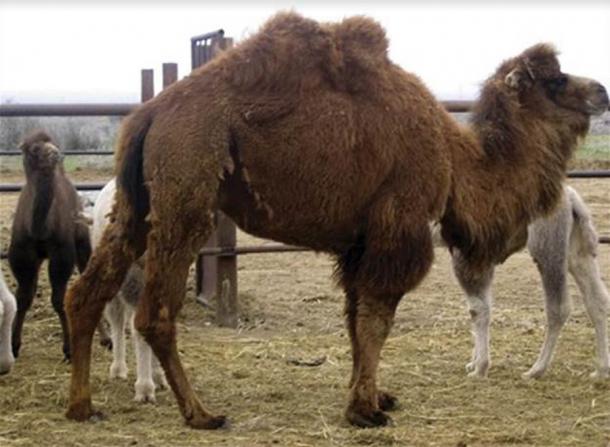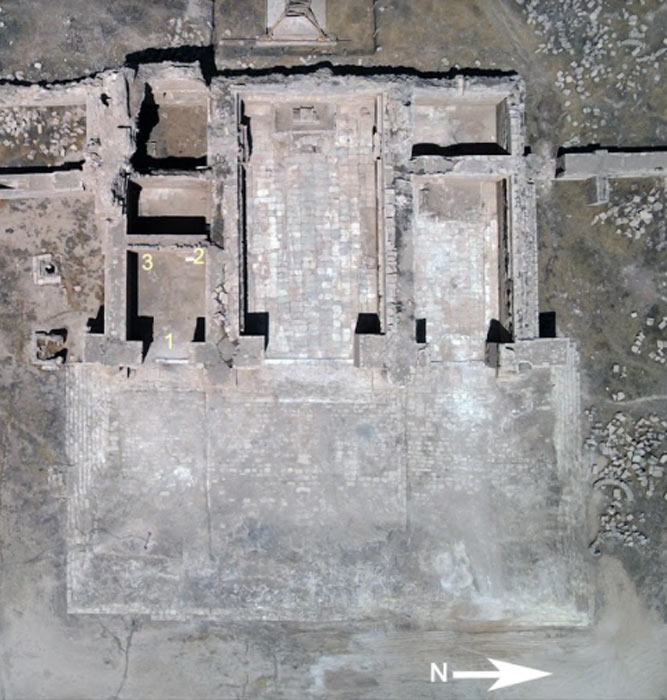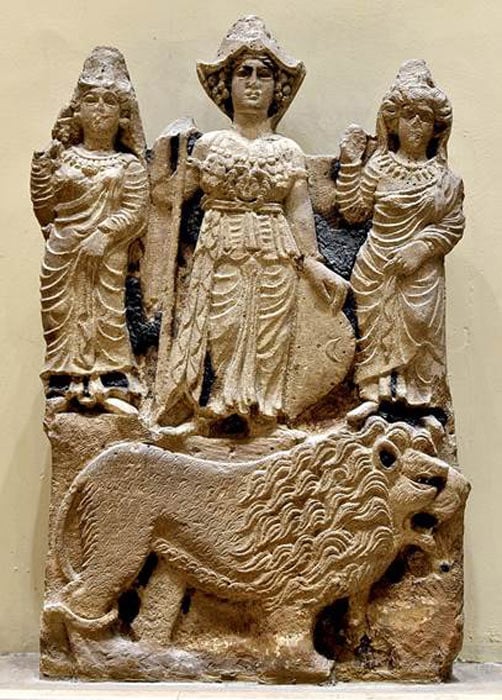
Evidence of Camel Hybridization Found in Ancient Temple in Hatra, Iraq
The Temple of Allat is a well-preserved 2,000-year-old monument located at the site of the ancient market city of Hatra in northern Iraq. Allat was a pre-Islamic Arabian goddess who was widely worshipped in the Middle East during the early centuries of the first millennium. In the second century AD, on a lintel above one of the temple’s inner entrances, an ancient sculptor created an image of a king’s head surrounded by two lines of five camels on each side. Previous examinations of the carvings had identified the camels as a mixture of dromedaries and Bactrian camels, which were the two types of camels that traders and agricultural laborers were using in Hatra at that time. Dromedaries were a local type of camel, while Bactrians were a Central Asian variety that would have been imported into the region from the east.

Decoration of the inner door of the southern iwan, with detail of the lintel, at the Temple of Allat in Hatra, Iraq. (Photograph courtesy of the Aliph-ISMEO project at Hatra / Antiquity Publications Ltd).
Hatra Camel Depictions Led To New Hybrid Perspective
Recently, a trio of scholars, including Italian researchers Massimo Vidale and Stefania Berlioz and Rowaed Mohammed from the State Board of Antiquities and Heritage in Mosul, Iraq, had a chance to re-examine the Hatra carved rock display (or frieze), during an ongoing restoration project at the Temple of Allat.
- Does latest dating of camel bones reveal inaccuracy in the Bible?
- Stone Age Etchings of Camel Fight Found on Siberian Mammoth Tusk
Through a careful and detailed analysis, which they’ve just published in the journal Antiquity, the researchers were able to show that the two camels at the head of each line are actually hybrids.

Left: Two-humped camels flanking a royal portrait in the center of the lintel. Right: Comparing the two-humped camels (a–b) with dromedaries (c) on the same lintel (Photograph courtesy of the Aliph-ISMEO project at Hatra / Antiquity Publications Ltd).
In other words, their characteristics include a combination of those possessed by dromedaries and Bactrian camels. This suggested that the king in the frieze (assumed to be Sanatruq I, the first monarch of the Kingdom of Hatra) was somehow involved in the interbreeding of these two types of camels, and that he wanted visitors to the temple to know about his activities.

A Camelus bactrianus / dromedarius hybrid in Kazakhstan. (Reproduced, with permission, from Alhadrami & Faye 2016 / Antiquity Publications Ltd).
A Politically Calculated Renovation at the Temple of Allat
The Temple of Allat went through various construction phases. During a 168 AD renovation, Sanatruq I ordered several additions to interior and exterior sections of the building.
On the interior, these included the installation of life-sized sculptures of himself and his son, Crown Prince Abdsamiya, who would succeed his father as king a decade later. He also commissioned the creation of two new sculptures that showed the goddess Allat riding a dromedary, an animal that was always closely associated with her worship. On the exterior of the building, he added four more reliefs featuring dromedaries, which were impossible for visitors to miss since they flanked the temple’s outer entrance.

Aerial view of the Temple of Allat, Hatra, Iraq: 1) entrance to the southern hall; 2) location of the door and lintel; 3) location of the statues of King Sanatruq I and his son (Photograph courtesy of the Aliph-ISMEO project at Hatra / Antiquity Publications Ltd).
With this activity, Sanatruq I revealed his interest in promoting the cult of Allat. Hatra was one of the major centers of Allat worship in the second century, and it made sense from a political perspective for Sanatruq I to signal his allegiance to the goddess and respect for her sacred animal.
Meanwhile, his creation of a frieze that explicitly connects him to camel hybrids and breeding programs also seems designed to provoke a positive political response. Dromedary and Bactrian camels have been successfully bred in the Middle East and Western Asia for centuries, and their hybrids are known to be twice as strong as non-hybridized versions either type. Hybrids are also able to withstand extreme temperatures in summer and winter better than non-hybrids, which only adds to their suitability for carrying heavy packs and performing other types of work in agricultural settings.
A Kingdom Secured by Camels
Hatra in the second century was a cosmopolitan city, with an intriguing profile that would have made it a fascinating place to visit.
As one of the most important religious meccas in the ancient Middle East, Hatra was a place where religious seekers could find temples devoted to gods and goddesses from multiple cultures. The Temple of Allat was one of its most prominent temples, devoted as it was to an Arabian goddess who was worshipped throughout Mesopotamia and on the Arabian Peninsula.

Relief of the Arabian goddess Allat (center), Manat, and al-Uzza from Hatra, in the Iraq Museum. (CC BY-SA 4.0)
In addition to its importance as a spiritual center, Hatra was also a popular stopping point for those who traveled up and down the Silk Road, a network of trading roads, passages, and pathways that connected China and the Far East with the Middle East and Europe. The marketplaces of Hatra were crowded and busy, as people arrived from throughout the region to acquire goods brought from far away.
Despite its supposed independence, the Kingdom of Hatra (first recognized in 140 AD) was actually a second-century creation of the Parthian Empire, a Persian/Iranian political entity located on Hatra’s western border.
Hatra was an important ally of the Parthians during their ongoing struggle to keep the expansionist Roman Empire at bay, which resulted in a series of conflicts (the Roman-Parthian Wars) that lasted from 54 BC to 217 AD. The Romans couldn’t reach Parthian territory without passing through Hatra first, and in fact the people of Hatra were forced to defend themselves against Roman attacks several times in the second century.

General view of the Temple of Allat, Hatra. (Photograph courtesy of the Aliph-ISMEO project at Hatra / Antiquity Publications Ltd).
As the very first individual to be recognized as the King of Hatra, in 140 AD, Sanatruq I was faced with the challenge of gaining the support of the local population. To a large extent he would have still been considered a figurehead, someone appointed to his position by the Persians because they knew he would deploy his armies against the Romans to protect the Parthian Empire from invasion.
In order to establish his legitimacy, it would have been in Sanatruq’s best interest to demonstrate his respect toward local religious traditions. He did this by creating sculptures and friezes dedicated to the goddess Allat, in a city where the cult of worship that surrounded this deity was strong and thriving.
- The Haunted Ruins of Khara Khoto, The Black City of Mongolia
- Footprints Reveal Passage of Early Humans From Africa Through Arabia
Perhaps even more importantly, he could have established his legitimacy by offering material support to camel breeding, as a financial patron or even as the local official in charge of that process. Consequently, it would have made sense for him to install the frieze featuring his image next to two hybrid camels inside the Temple of Allat, since locals frequently visited this important sacred site.
If Sanatruq I was indeed attempting to cement his reputation as a patron of local camel breeding programs, his use of imagery in a revered religious temple demonstrated his savvy with respect to marketing and public relations. His display of the dromedary/Bactrian camel hybrids let everyone know he planned to continue importing Bactrian camels from Central Asia, making sure there would be a steady supply of hybrids available to local merchants, farmers, and traders. All indications are that Sanatruq I enjoyed a calm and uncontested reign, (as did his son), which suggests his attempts to ensure the loyalty of his subjects was successful.
Top image: The Temple of Allat in Hatra, Iraq. Right: camel relief comparisons. Source: Photograph courtesy of the Aliph-ISMEO project at Hatra / Antiquity Publications Ltd.
By Nathan Falde















